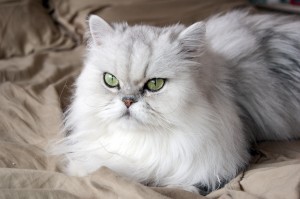Of all the cat breeds in the world, none is more distinctive or highly recognized than the Persian. Their look is almost stately, conjuring images of riches and opulence, especially white Persian cats, but this breed brings to the table more than simply good looks. Their calm and loving temperament makes them a joy to have around the house and a wonderful, loyal companion.
History
Persians have a lengthy and interesting history. They were first thought to have originated in Iran, which is where Persia once existed. Although this may be true, the modern Persian breed has lost its genetic signature. The modern breed we see today is felt to have, for the most part, developed in Western Europe, specifically Britain. It was not until after World War II that American breeders recognized the inherent beauty of the Persian and began breeding them. Now, the Persian is the most popular breed in the United States.
 Characteristics
Characteristics
Persians are set apart from other breeds by their extremely thick coat, wide head, large eyes, and shortened muzzle. In the United States, a movement began in the 1950′s to produce an exaggeratedly flat face, known as peke-faced, but this gave way to health problems. While the peke-faced look is still very popular, the health problems associated with it caused many breeders in the mid-1990′s to abandon selective breeding practices to produce that characteristic. The traditional look of the Persian includes a more elongated muzzle than what we see today and many are now selectively breeding to produce the more traditional looking version of the breed.
Temperament
Dignified, calm, and gentle are three words that come to mind when describing the personality of the Persian. They are very quiet and affectionate, making them a favorite for apartment dwellers. They are content in nearly any environment so long as they are afforded enough attention. Although they do well around other pets, Persians need human companionship and should not be left alone for long periods of time.
Grooming
It should be noted that while most cats are able to groom themselves, the extra dense coat of the Persian prevents it from being able to do so. Regular bathing and brushing of the coat is necessary to keep the coat from matting. Additionally, the large eyes of the Persian can cause excessive tears that run down the face of the cat. Any ocular discharge and crusting should be cleaned each day to prevent staining of the fur around the eyes.
Variations
Persian cats have such a long and extensive history and have been popular for so long that there are many variations of the breed, some of which have given birth to other popular breeds. Himalayans are, in fact, a result of cross breeding Persians with Siamese cats. Exotic short-hair versions of the Persian breed were a result of crossing Persians with American Short-Hair cats. In South Africa, breeders were successful at selectively breeding specific characteristics to produce what is now known as the Chinchilla Longhair breed, featuring a longer muzzle and translucent hair with dark tips.
Health Concerns
The distinctive facial features of the Persian, especially in the peke-faced variations, can cause breathing and eye difficulties. Excessive tearing and corneal damage due to eyelashes rubbing against the eye are also two common problems with this breed. Aside from this, birthing problems are also common in this breed and the rate of stillbirths is much higher in Persians than other breeds at between 16% and 22%. Other health problems that may be seen in Persian cats are polycystic kidney disease, hypertrophic cardiomyopathy, and progressive retinal atrophy.
Persian Cat Rescue
It’s hard to believe, but there are Persians out there who do not have a loving home.  Even this beautiful, distinctive cat sometimes finds itself in need of adoption for one reason or another and there are rescue centers scattered throughout the country that have Persians available for adoption.
Even this beautiful, distinctive cat sometimes finds itself in need of adoption for one reason or another and there are rescue centers scattered throughout the country that have Persians available for adoption.
One such rescue center is www.persiancats.org. It should be noted that this website does not ship cats due to the stress it causes the animal and the number of cats that are in need of good homes everywhere. They recommend searching local shelters and rescue centers first. Any individual visiting the website above should be forewarned that the sweet, beautiful faces they are about to see will indeed pull on the heartstrings and they just might find themselves on the phone shortly searching local shelters for a Persian of their own.

Please contribute to this article discussion and post a comment below...
Powered by Facebook Comments